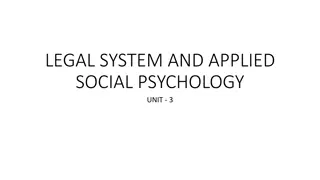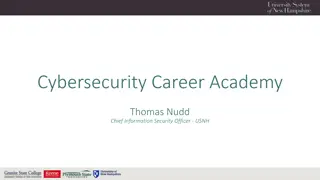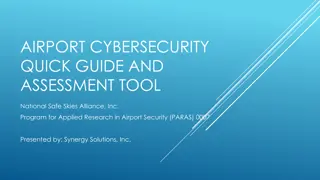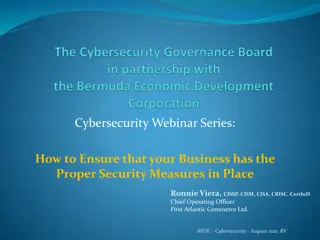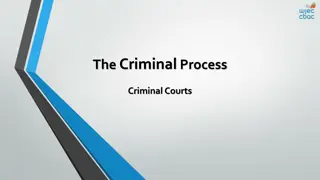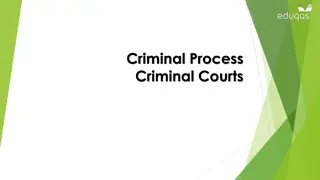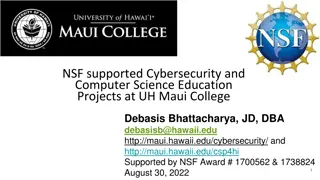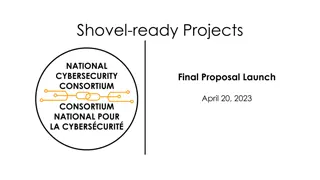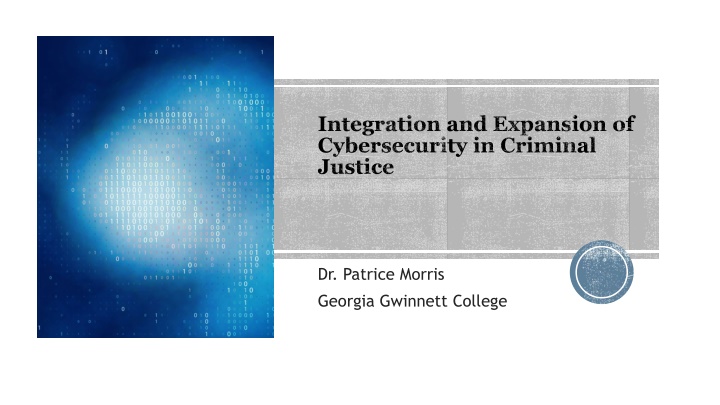
Integrating Cybersecurity in Criminal Justice Programs
Explore the integration and expansion of cybersecurity in criminal justice programs, addressing the growing threat of cybercrime in today's virtual world. Discover the role of criminal justice disciplines in cybersecurity, the demand for cybersecurity professionals, and the urgency to bridge the gap in educational programs. Join the discussion on enhancing cybersecurity awareness in the criminal justice sector to combat malicious cyber activities effectively.
Download Presentation

Please find below an Image/Link to download the presentation.
The content on the website is provided AS IS for your information and personal use only. It may not be sold, licensed, or shared on other websites without obtaining consent from the author. If you encounter any issues during the download, it is possible that the publisher has removed the file from their server.
You are allowed to download the files provided on this website for personal or commercial use, subject to the condition that they are used lawfully. All files are the property of their respective owners.
The content on the website is provided AS IS for your information and personal use only. It may not be sold, licensed, or shared on other websites without obtaining consent from the author.
E N D
Presentation Transcript
Integration and Expansion of Cybersecurity in Criminal Justice Dr. Patrice Morris Georgia Gwinnett College
Integrating Cybersecurity in Criminal Justice Programs We live in a virtual world. But this virtual world is rife with crime cybercrime! Cybersecurity and cyber-attacks are the norm today. As noted by Chopin and D cary-H tu (2023:3), it is undeniable that an increasingly large part of criminal activity occurs either partly or wholly within a virtual environment. The term cybercrime has been frequently used instead of computer crime in late 1990s to describe criminal behavior committed in cyberspace using computers (Payne, 2016). According to Payne and Hadzhidimova (2018), internet crime, cyber crime, are now part of the criminological lexicon.
Integrating Cybersecurity in Criminal Justice Programs The United States faces persistent and increasingly sophisticated malicious cyber campaigns that threaten the public sector, the private sector, and citizens security and privacy. The Federal Government has a mandate that it must improve its efforts to identify, deter, protect against, detect, and respond to these actions and actors. Given the magnitude of cybercrime threats and the seriousness of its impact, much attention has been directed toward developing certifications, trainings, and degree programs in cybersecurity.
Integrating Cybersecurity in Criminal Justice Programs In a special issue on cybersecurity and criminal justice, in the journal Criminal Justice Studies, Payne (2016) contends that an important question that remains is what role does the criminal justice discipline play in the field of cybersecurity? In the past few years there has been an increasing need for cybersecurity professionals (Payne et al., 2021) from diverse educational backgrounds and groups (Saddiqa et al., 2024) including those from disciplines such as criminal justice.
Integrating Cybersecurity in Criminal Justice Programs Cyber security careers are on the rise with numerous job openings in the different sectors (Payne and Hadzhidimova, 2018) and approximately half a million unfilled cybersecurity professionals in 2020. (Payne et al., 2020). There is a cybersecurity workforce shortage in the US and globally (Quintana et al., 2024) and a push to recruit people with various skills from different academic backgrounds (Tsado and Kim, 2022). Yet, very few criminal justice programs (undergraduate and graduate) offer courses in cybersecurity. Quintana and colleagues (2024) lament that criminal justice as a discipline lags behind.
Integrating Cybersecurity in Criminal Justice Programs There are several explanations for the slow integration and study of cybersecurity in criminal justice programs. First, cybersecurity is a relatively new area academic focus (Payne and Hadzhidimova, 2018). While there has been development of cybersecurity academic programs in the STEM field, there is delayed response to expand the study of cybersecurity to other disciplines (Tsado and Kim, 2022; Saddiqa et al., 2023; Nodeland et al., 2019). Cybersecurity is not seem as an appealing area of focus for social scientist as most criminal justice programs focus on crime and justice from a sociological perspective (Payne and Hadzhidimova, 2018).
Integrating Cybersecurity in Criminal Justice Programs Nodeland and colleagues (2019) posit that with limited budgets, the cost of developing a new program may be a contributing factor for the lack of cybersecurity courses in criminal justice. Cybersecurity is perceived as a highly technical field with a focus on technology topics such as network defense, programming, digital forensics, and identity fraud (Saddiqa, et al., 2023; Tsado and Kim, 2022). However, studying, understanding, controlling, managing, and preventing cybercrime is not limited to computer science experts or information technology analysts. Cybercrime is interdisciplinary and requires the expertise of those in the police and courts systems (Payne et al., 2021; Tsado and Kim, 2022; Nodeland et al., 2019).
Integrating Cybersecurity in Criminal Justice Programs There are limited graduate programs in criminal justice with cybersecurity courses. Few criminal justice programs fully embrace cybersecurity education (Quintana and colleagues, 2024). For some institutions, faculty are not able to teach courses without specific credentials. With little to no graduate level criminal justice cybersecurity courses, and research in cybersecurity, only few criminal justice/criminology faculty are able to teach cybersecurity courses in their respective departments.
Integrating Cybersecurity in Criminal Justice Programs Nationwide, only 16 percent of criminal justice programs have cybersecurity coursework, while 17 percent of cybersecurity programs have a criminal justice course (Payne and Hadzhidimova, 2018). Overall, there are limited criminal justice programs with cybersecurity courses (Nodeland, Belshaw, and Saber, 2019; Qunitana et al., 2024). The argument is made by Payne and Hadzhidimova (2018: 401) that, the technological revolution changed the way crime is committed. It should also change the topics we study and teach about in criminal justice.
Integrating Cybersecurity in Criminal Justice Programs Including cybersecurity courses in a criminal justice curriculum has many benefits to a department, the students, and the faculty. These courses have the potential to pave the way for more job opportunities in criminal justice and technology and prepare students for fulfilling careers in cybersecurity (Tsado and KIm, 2022). Criminal justice departments are able to be relevant and stay abreast of current trends in the growing and demanding field of cybersecurity.
Integrating Cybersecurity in Criminal Justice Programs The cybersecurity field lacks a diverse workforce and has a dire need for more women and minorities as well as representation from various educational backgrounds. Many criminal justice majors are females and minorities. According to Saddiqa and colleagues (2023: 2), The need for a diverse and inclusive cybersecurity workforce is not only a matter of social justice and equity but is also essential for addressing the complex and evolving challenges of cybersecurity in today's world.
Criminal Justice Cybersecurity Courses Security Ethics Cybersecurity Laws and Policies Digital Forensics Ethical hacking Introduction to Cybersecurity Cybersecurity and Loss Prevention Cybercrime Cyber technologies for Criminal Justice Cyber crimes and the courts
Criminal Justice/Cybersecurity Agencies/Jobs Cybersecurity falls under the Department of Homeland Security with a main mandate to investigate malicious cyber activity. The United States Secret Service (USSS) investigates a range of cyber-enabled crime with a particular focus on protecting the nation s financial infrastructure. The Secret Service cybercrime mission focuses on acts that target and threaten the American financial system, such as network intrusions and ransomware, access device fraud, ATM and point-of-sale system attacks, illicit financing operations and money laundering, identity theft, social engineering scams, and business email compromises. Through the agency s Cyber Fraud Task Forces (CFTF), the Secret Service brings together critical partners, to include other law enforcement agencies, prosecutors, private industry, and academia, to pursue a comprehensive response to the threat.
Criminal Justice/Cybersecurity Agencies/Jobs The United States Coast Guard (USCG) enables operations at sea, in the air, on land and space by delivering effects and capabilities in and through cyberspace. It is the nation s lead federal agency for securing and safeguarding the maritime domain. In its role as a military, law enforcement, and regulatory agency, the Coast Guard has broad authority to combat cyber threats and protect U.S. maritime interests both domestically and abroad. In support of the Maritime Transportation System (MTS), the Coast Guard continually promotes best practices, identifies potential cyber- related vulnerabilities, implements risk management strategies, and has in place key mechanisms for coordinating cyber incident responses.
Criminal Justice/Cybersecurity Agencies/Jobs Immigration and Customs Enforcement - Homeland Security Investigations (ICE HSI) is a worldwide law enforcement leader in dark net and other cyber-related criminal investigations. HSI's Cyber Crimes Center (C3) delivers computer-based technical services to support domestic and international investigations into cross-border crime. C3's Child Exploitation Investigations Unit (CEIU) is a powerful tool in the fight against the sexual exploitation of children; the production, advertisement and distribution of child pornography; and child sex tourism. The FBI is the lead federal agency for investigating cyber attacks and intrusions. We collect and share intelligence and engage with victims while working to unmask those committing malicious cyber activities, wherever they are. The FBI has specially trained cyber squads in each of our 56 field offices, working hand-in- hand with interagency task force partners. The rapid-response Cyber Action Team can deploy across the country within hours to respond to major incidents.
References Chopin, J., & D cary-H tu, D. (2023). Dark web pedophile site users cybersecurity concerns: A lifespan and survival analysis. Journal of Criminal Justice, 86, 1 9. Nodeland, B., Belshaw, S., & Saber, M. (2019). Teaching cybersecurity to criminal justice majors. Journal of Criminal Justice Education, 30(1), 71-90. Payne, B. K. (2016). Editor's introduction: Special issue on cybersecurity and criminal justice. Criminal Justice Studies: Critical Journal of Crime, Law and Society, 29(2), 89-91. Payne, B. K., & Hadzhidimova, L. (2018). Cyber security and criminal justice programs in the United States: Exploring the intersections. International Journal of Criminal Justice Sciences, 13(2), 385-404.
References Payne, B. K., He, W., Wang, C., Wittkower, D. E., & Wu, H. (2021). Cybersecurity, technology, and society: Developing an interdisciplinary, open, general education cybersecurity course. Journal of Information Systems Education, 32(2), 134 149. Quintana, K., Sutton Chubb, C., Olson, D., & Kosloski, A. (2024). Cybersecurity skills, knowledge and abilities for criminal justice professionals: An exploratory study of practitioners perspectives. Journal of Cybersecurity Education, Research & Practice, 2024(1). Saddiqa, M., Larsen, K. H.L.H., Nielsen, R., and Pedersen, J. (2023). Building a diverse cybersecurity workforce: A study on attracting learners with varied educational backgrounds. Journal of Cybersecurity Education, Research & Practice, 1, 1-11. Tsado, L., & Kim, J. S. Scott. (2022). Assessing the Practical Cybersecurity Skills Gained Through Criminal Justice Academic Programs to Benefit Security Operations Centers (SOCs). Journal of Cybersecurity Education, Research & Practice, 1, 1 21.





